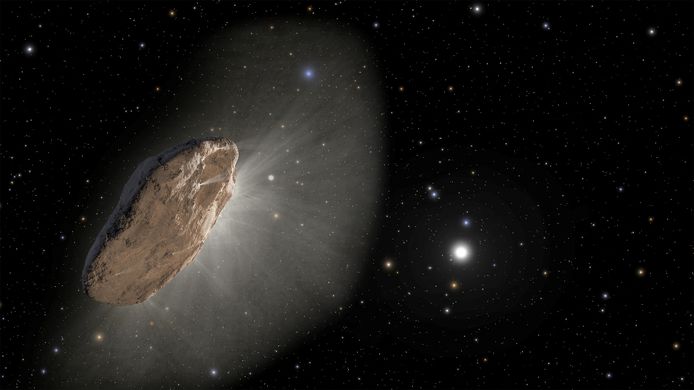In 2017, Oumuamua passed through our solar system. The first known space object to come from another solar system has fascinated people ever since, not only because of its bizarre cigar-like shape, but also because Oumuamua curiously accelerated away from the sun.
Since the passage of Oumuamua, there have been many speculations about the origin of the long rock. For example, a Harvard astronomer suggested that it could be a probe with which extraterrestrials explored our solar system. Others have suggested the most plausible explanation that the object was a shard of rock torn from another planet.
In a new study published in the scientific journal Nature the researchers now suggest that Oumuamua’s acceleration was due to the release of hydrogen gas as the comet warmed up in the sun.
crepe
Oumuamua lacks the gas and dust tail typical of many comets. The object was previously described as cigar-shaped and about 400 meters long, but is now said to be a rock pancake. The rock is smaller than originally thought and is now estimated to be around 115 meters by 111 meters, with a thickness of 19 meters.
According to the scientists, Oumuamua apparently formed like many other comets as a planetesimal: a small object that formed early in the formation of the planet and is actually a large icy space rock.
Pre-workout
After the object was, for some reason, catapulted from its home solar system and flown into space, the composition of the comet changed after exposure to high-energy radiation. As a result, some of the comet’s ice turned into hydrogen gas which was trapped by the rest of the ice.
Oumuamua then warmed up as it transited our solar system, rearranging the comet’s ice structure, releasing trapped hydrogen gas and energizing the comet as it moved away from the Sun. This process is known as “outgassing” and is not accompanied by tailing.

“The main finding is that ‘Oumuamua may have started out as a water-rich, icy planetesimal that is broadly similar to comets in the solar system. This model can explain ‘Oumuamua’s strange behavior without resorting to physics or chemistry. exotics,” said astrochemist Jenny Bergner of the University of California, Berkeley, lead author of the study.
It’s “the simplest explanation and exactly what we would expect for an interstellar comet,” said study co-author Darryl Seligman, a postdoctoral fellow in planetary sciences at Cornell University.
Oumuamua was first discovered by the University of Hawaii’s Pan-STARRS1 telescope. “We don’t know where it came from, but it probably traveled through interstellar space for less than 100 million years,” Seligman said.
A comet from another galaxy appears to have a ‘radically different and unusual composition’
Oumuamua space object could be a fragment of a Pluto-like celestial body
Free and unlimited access to Showbytes? That can!
Log in or create an account and don’t miss anything from the stars.

“Food expert. Unapologetic bacon maven. Beer enthusiast. Pop cultureaholic. General travel scholar. Total internet buff.”
 DodoFinance Breaking News Made For You!
DodoFinance Breaking News Made For You!
